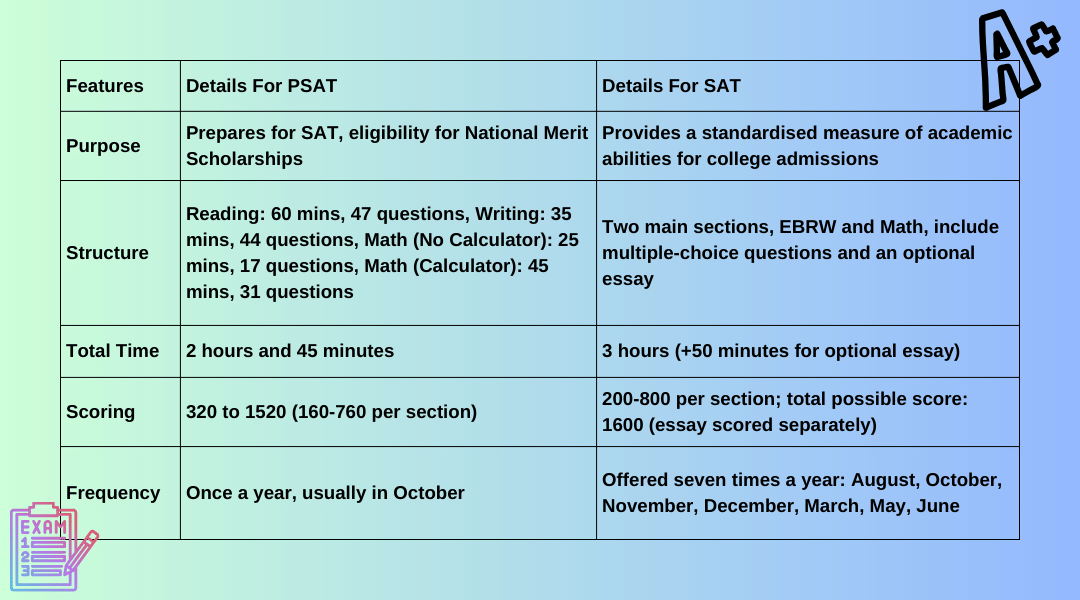Understanding the differences between PSAT Vs SAT is essential for students who aspire to get into the prestigious universities of their choice. While both tests assess students’ knowledge and readiness for college, they serve distinct purposes and have different formats and implications. The PSAT, often taken in the 10th and 11th grades, serves as a preparatory exam and a qualifying test for the National Merit Scholarship Programme. In contrast, the SAT is a major college admissions test typically taken in the junior or senior year of high school and plays a role in college admissions decisions.
In this blog, we will explore the key differences between the PSAT and SAT to help you better understand their respective roles and how they fit into your educational path.
What Is PSAT And SAT?
The PSAT, or Preliminary SAT/National Merit Scholarship Qualifying Test (PSAT/NMSQT), is a standardised test. It is designed primarily for high school students in grades 10 and 11. This test can be taken up to three times during high school, but only once yearly. It is a practice version of the SAT and the qualifying test for the National Merit Scholarship Programme.
The SAT is a standardised test widely used for undergraduate college admissions in the United States. It is designed to assess a student’s readiness for college by measuring their literacy, numeracy, and writing skills. Competitive universities and Ivy Leagues usually require these scores.
PSAT Vs SAT: Key Features
The PSAT (Preliminary SAT) and SAT are two important standardised tests in the American education system, designed to assess high school students’ academic skills and college readiness. While they share some similarities, these tests serve different purposes and have distinct characteristics. Understanding the key features of both the PSAT and SAT is crucial for students as they prepare for college admissions and potential scholarship opportunities. In this section, we have outlined the main attributes of each test.

Differences Between The PSAT Vs SAT
While these tests share some similarities in format and content, there are key differences between the two tests. Understanding these differences can help students better prepare for each exam and effectively utilise their results in college admissions.
- Structure and Content: Both the PSAT and SAT cover similar subjects, focusing on Evidence-Based Reading and Writing (EBRW) and Math. However, the SAT includes an optional essay section, which the PSAT does not. While the question types on both tests are largely the same, the SAT features more challenging questions that reflect the additional year of high school coursework, particularly in the maths section. This difference in difficulty level is designed to better assess students’ readiness for college-level work.
- Cost and Accessibility: The PSAT typically costs around $18, but many schools offer it free to students, making it more accessible and widely taken. On the other hand, the SAT costs about $55, with an additional fee for the optional essay section.
- Test Availability and Scheduling: The PSAT is usually administered once a year in October, while the SAT is offered multiple times throughout the school year, allowing students to take it as many times as they wish to improve their scores.
- Test Length and difficulty: The PSAT lasts approximately 2 hours and 45 minutes, whereas the SAT takes about 3 hours. The latter contains more questions and is generally considered more difficult due to its advanced content. The SAT, especially in the maths section, includes topics such as trigonometry and advanced algebra that may not be covered in the PSAT, making it slightly more challenging.
PSAT Vs SAT: How To Prepare
Preparing for the PSAT and SAT can be quite a task, but it becomes a manageable and even rewarding journey with the right strategies and mindset. Whether you are just starting your prep or looking to refine your approach, we have given a few tips to help you prep for your PSAT and SAT exams.
- Understand the Test Format: Familiarise yourself with the format of both the PSAT and SAT Tests, which are similar. However, the PSAT has fewer questions and no essay component. Knowing the structure will help you manage your time during the exam.
- Set a Target Score: Establish a specific target score based on your college aspirations or National Merit Scholarship goals. This will give you a clear objective to work towards and help you stay motivated throughout your preparation.
- Take Practice Tests: Taking practice tests is crucial as it will not only help you understand the types of questions you will face but also allow you to track your progress. Simulate real testing conditions to accurately understand your strengths and weaknesses. After each test, analyse your performance to identify areas that need improvement.
- Analyse Your Mistakes: Review your incorrect answers After completing practice tests to identify improvement areas. Understanding why you missed questions will help you focus your study efforts more effectively.
- Create a Study Schedule: Develop a consistent study routine that fits your schedule. Allocate specific times each week for focused study sessions.
- Enhance Reading Skills: Engage with challenging materials to increase your reading frequency. This will improve your comprehension and speed, which are essential for the reading sections of both tests.
- Consider Test Prep Classes: If you prefer structured guidance, consider enrolling in test prep classes. These classes can provide expert instruction and additional resources to help you prepare effectively.
Eligibility Criteria And Documents Required For PSAT Vs SAT
Understanding the eligibility criteria and required documents is crucial for a smooth and successful registration process when preparing for the PSAT and SAT. Below, we have provided details about the eligibility criteria and the documents required for both tests.
1. Eligibility Criteria For PSAT:
The PSAT is primarily taken by students in 10th and 11th grades, with the PSAT/NMSQT intended for 11th graders and the PSAT 10 for 10th graders. Additionally, the PSAT 8/9 is available for 8th and 9th graders. Students must be enrolled in high school, whether traditional or homeschooled and progressing toward graduation. To qualify for the National Merit Scholarship Programme, students must take the PSAT/NMSQT during their junior year (11th grade) and meet additional criteria, such as planning to attend college after high school.
2. Documents Required For PSAT:
Registration for PSAT is usually done through the student’s school. During this process, students may need to submit personal details, including their name, school, and grade level.
3. Eligibility Criteria For SAT:
There are no specific grade level requirements for the SAT, but most students take it in their junior or senior year of high school. Like the PSAT, students must be enrolled in high school or have completed high school to be eligible for the SAT.
4. Documents Required For SAT:
Students can register for the SAT online through the College Board website. There, they will need to provide personal information such as their name, date of birth, and school details. On test day, they must bring an acceptable photo ID, such as a driver’s licence or school ID, along with their admission ticket, which they print after registration.
FAQs
1. What is the difference between PSAT Vs SAT?
The SAT is slightly more challenging than the PSAT. The PSAT is between 320 and 1520, whereas the SAT scores between 400 and 1600.
2. Is the PSAT equal to the SAT?
Although the PSAT is somewhat less advanced than the SAT, it still covers comparable material, including reading, writing, and math concepts.
3. What SAT score is required for Harvard?
Admitted students at Harvard University typically have SAT scores ranging from 1480 to 1580, with an average score of 1530.
4. What happens if you take the PSAT?
A strong PSAT score often predicts a strong SAT score, which can help you secure scholarships and grants for college.
5. Who takes the PSAT?
Students from 8th to 11th grade can typically take the PSAT, depending on their school and grade level.
We hope you found this blog engaging for more such reads click on the links below















0 Comments